 W
WThe Acuario Nacional de Cuba is an aquarium in Havana, Cuba established in 1960 to focus on "research and environmental education". Displays include those of coral and other tropical species, as well as a dolphinarium and sea lion shows.
 W
WLa Bodeguita del Medio is a restaurant-bar in Havana, Cuba. La Bodeguita lays claim to being the birthplace of the Mojito cocktail, prepared in the bar since its opening in 1942, although this is disputed. It has been patronized by Salvador Allende, the poet Pablo Neruda, the artist Josignacio and many others. The rooms are full of curious objects, frames, photos, as well as the walls covered by signatures of famous or unknown customers, recounting the island's past.
 W
WThe Campo de Marte is a park in Havana, Cuba. It was built in the 1790s as a military practice range by the Spanish governtment; it was expanded in 1793 by Belgian engineer Agustin Cramer, and later the Bishop Espada improved the lighting of the Campo. It was Captain General Don Miguel Tacón who included it within the scope of his embellishment program. The area was then fenced and four majestic gates, crowned with coats of arms, each representing an important personality: the north gate, Hernán Cortés; the south one, Francisco Pizarro; and the east and west gates, Captain General Miguel Tacón y Rosique (1834-1838), and Christopher Columbus respectively.
 W
WThe Castillo de la Real Fuerza is a bastion fort on the western side of the harbour in Havana, Cuba, set back from the entrance, and bordering the Plaza de Armas. Originally built to defend against attack by pirates, it suffered from a poor location; it was too far inside the bay. The fort is considered to be the oldest stone fort in the Americas, and was listed in 1982 as part of the UNESCO World Heritage Site of "Old Havana and its Fortifications".
 W
WThe Christ of Havana is a large sculpture representing Jesus of Nazareth, on a hilltop overlooking the bay in Havana, Cuba. It is the work of the Cuban sculptor Jilma Madera, who won the commission for it in 1953.
 W
WEl Cementerio de Cristóbal Colón, also called La Necrópolis de Cristóbal Colón, was founded in 1876 in the Vedado neighbourhood of Havana, Cuba to replace the Espada Cemetery in the Barrio de San Lázaro. Named for Christopher Columbus, the cemetery is noted for its many elaborately sculpted memorials. It is estimated the cemetery has more than 500 major mausoleums. Before the Espada Cemetery and the Colon Cemetery were built, interments took place in crypts at the various churches throughout Havana, for example, at the Havana Cathedral or Church Crypts in Havana Vieja.
 W
WThe Convento de Santa Clara de Asis is a convent in Havana, Cuba. Built in the 17th century, the convent has since been partially abandoned and converted into a storehouse.
 W
WEl Capitolio, or the National Capitol Building, is a public edifice and one of the most visited sites in Havana, capital of Cuba. The building was commissioned by Cuban president Gerardo Machado and built from 1926 to 1929 under the direction of Eugenio Rayneri Piedra. It is located on the Paseo del Prado, Dragones, Industria, and San José streets in the exact center of Havana.
 W
WBuilt in 1827, El Templete commemorates the site of the first mass and town council of San Cristóbal de la Habana celebrated on November 16, 1519.
 W
WLa Fábrica de Arte Cubano is an art gallery and club in Havana, Cuba. The Fábrica's gallery and stage were established inside of a former cooking oil factory, and has since gained notoriety as one of Havana's premier nightclubs and art galas. Several news outlets have described the factory as a symbol of Cuba's accelerating opening to the world.
 W
WFloridita or El Floridita is a historic fish restaurant and cocktail bar in the older part of Havana, Cuba. It lies at the end of Calle Obispo, across Monserrate Street from the National Museum of Fine Arts of Havana. The establishment is famous for its daiquiris and for having been one of the favourite hangouts of Ernest Hemingway in Havana. The bar now boasts a life size bronze statue of Ernest Hemingway positioned in his favourite spot at the end of the bar. On a small plaque hanging in El Floridita, hangs Hemingway's signed quote: "My mojito in the Bodeguita del Medio and my daiquiri in the Floridita".
 W
WGuanabo is a beach town in the Ciudad de la Habana Province of Cuba. It is a ward located within the municipality of Habana del Este halfway between the centre of Havana and Santa Cruz del Norte, at the mouth of the Guanabo River, between the Atlantic Ocean coast and the Sierra del Canchón.
 W
WThe Bienal de La Habana was founded in 1984. It takes place in Havana (Cuba) every two years. It principally aims at promoting the developing world in contemporary art circles, giving priority to Latin American and Caribbean artists, although artists from all over the world submit works.
 W
WHavana Cathedral is one of eleven Catholic cathedrals on the island. It is located in the Plaza de la Catedral on Calle Empedrado, between San Ignacio y Mercaderes, Old Havana. The thirty by forty-nine meters rectangular church serves as the seat of the Roman Catholic Archdiocese of San Cristobal de la Habana. Christopher Columbus’ remains were kept in the cathedral between 1796 and 1898 before they were taken to Seville Cathedral.
 W
WHavana Central is the main railway terminal in Havana and the largest railway station in Cuba, is the hub of the rail system in the country. It serves for the arrival and departure of national and divisional commuter trains, and is home to the national railway company, Ferrocarriles Nacionales de Cuba (FFCC), the only intercity passenger rail transport operating in the Caribbean.
 W
WThere is an abandoned Jai alai court in the back of the Hermanos Ameijeiras Hospital, the site of the old Casa de Beneficencia, on Calles Concordia and Lucenas near Calle Belascoain, an area that had been considered in the early part of the city as a place to locate the helpless and the unwanted, it was the edge between the city and the countryside; the spectator stands were parallel to Calle Concordia, the front wall of the court faced Calle Lucenas, East in the direction towards Old Havana. The original building has been annexed by fivr stories of residential concrete construction on the Northside along Calle Virtudes. The Havana Jai alai fronton was known as "the palace of screams".
 W
WThe Havana Plan Piloto was a 1955–1958 urban proposal by Town Planning Associates, which included Paul Lester Wiener, Paul Schulz, the Catalan architect Josep Lluis Sert, and Seely Stevenson of Value & Knecht, Consulting Engineers, seeking to combine "architecture, planning, and law", in a project heavily influenced by the politics of Fulgencio Batista which in turn were dictated by his involvement with the American Mafia and their desire to augment United States tourism, and thru his architects and various designers, the modernist principles of the Congrès Internationaux d'Architecture Moderne (CIAM) and the Athens Charter. The Charter got its name from the location of the fourth CIAM conference in 1933, which, due to the deteriorating political situation in Russia, took place on the in SS Patris II bound for Athens from Marseilles. This conference is documented in a film commissioned by Sigfried Giedion and made by his friend László Moholy-Nagy "Architects' Congress". The Charter had a significant impact on urban planning after World War II and, thru Josep Lluis Sert and Paul Lester Wiener, on the proposed modernization of Havana and in an effort to erase all vestiges of the 16th-century city.
 W
WThe University of Havana or UH is a university located in the Vedado district of Havana, the capital of the Republic of Cuba. Founded on January 5, 1728, the university is the oldest in Cuba, and one of the first to be founded in the Americas. Originally a religious institution, today the University of Havana has 15 faculties (colleges) at its Havana campus and distance learning centers throughout Cuba.
 W
WThe Hotel Ambos Mundos is a hotel in Havana, Cuba. Built with a square form with five floors, it has an eclectic set of characteristics of 20th-century style architecture. It was built in 1924 on a site that previously had been occupied by an old family house on the corner of Calle Obispo and Mercaderes in Old Havana. It is a frequent tourist destination because it was home to the popular writer Ernest Hemingway for seven years in the 1930s.
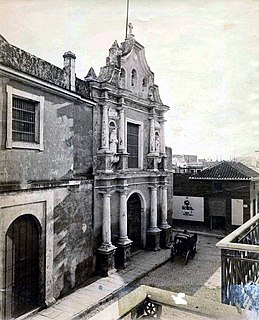 W
WThe Iglesia de San Francisco de Paula, Havana is part of the ecclesiastical heritage of Havana. It is located at 110 Calle Leonor Pérez on the corner of Calle San Ignacio. It is near the bay on the south side of Havana Vieja."
 W
WThe Iglesia del Espíritu Santo at #161 Calle Acosta was built in 1635 on the corner of the corner of Calles Cuba and Acosta by a fraternity of Afro-Cuban ex slaves. The Espíritu Santo contains some notable paintings including a seated, post-crucifixion Christ on the right wall, and catacombs. It is considered one of the oldest temples in Havana and it is said that its main interest lies essentially in the simplicity or simplicity of the beautiful stone construction.
 W
WThe Iglesia del Santo Cristo del Buen Viaje is located in Havana Vieja on Calle Cristo between Calles Lamparilla y Teniente Rey. Built at a time in which transatlantic crossings were risky, it acquired popularity during colonial times as a temple dedicated to travelers and navigators. Travelers and especially sailors would visit before leaving on a journey, and to pay their respects upon arriving back on land. Later during Cuba's republican era, the devotion to Santa Rita was added to the church.
 W
WJohn Lennon Park or Parque John Lennon is a public park, located in the Vedado district in Havana, Cuba.
 W
WThe Alameda de Paula is a promenade in Havana, Cuba, and was the first to be built in the city.
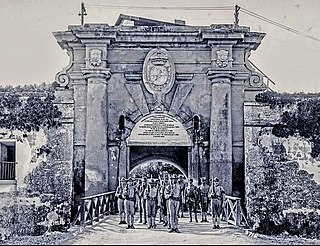 W
WFortaleza de San Carlos de la Cabaña, colloquially known as La Cabaña, is an 18th-century fortress complex, the third-largest in the Americas, located on the elevated eastern side of the harbor entrance in Havana, Cuba. The fort rises above the 200-foot hilltop, along with Morro Castle. The fort is part of the Old Havana World Heritage Site which was created in 1982.
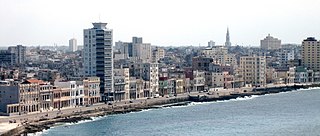 W
WThe Malecón is a broad esplanade, roadway, and seawall that stretches for 8 km along the coast in Havana, Cuba, from the mouth of Havana Harbor in Old Havana, along the north side of the Centro Habana neighborhood and the Vedado neighborhood, ending at the mouth of the Almendares River. New businesses are appearing on the esplanade due to economic reforms in Cuba that now allow Cubans to own private businesses.
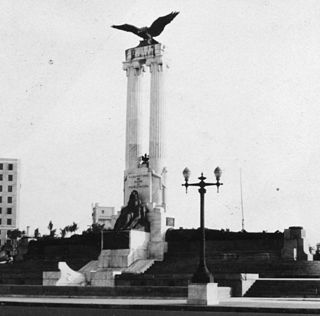 W
WThe Monument to the Victims of the USS Maine was built in 1925 on the Malecón boulevard at the end of Línea Calle, in the Vedado neighborhood of Havana, Cuba.
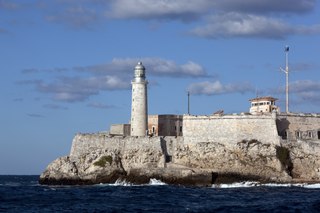 W
WMorro Castle, named after the three biblical Magi, is a fortress guarding the entrance to Havana bay in Havana, Cuba. The design was drawn up by the Italian engineer Battista Antonelli; originally under the control of Spain, the fortress was captured by the British in 1762, and was returned to the Spanish under treaty terms a year later.
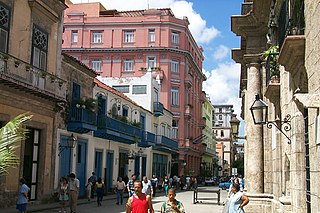 W
WThe Obispo Street is one of the most famous and traveled streets of Old Havana. During its history it has received several names such as: San Juan, Bishop (Obispo), Weyler, Pi Margall, among others, for a total of 47. It is the longest Street in Old Havana. Street shops have always been abundant alongside O'Reilly Street, which is parallel to it from its inception from Zulueta to Havana Bay.
 W
WOld Havana is the city-center (downtown) and one of the 15 municipalities forming Havana, Cuba. It has the second highest population density in the city and contains the core of the original city of Havana. The positions of the original Havana city walls are the modern boundaries of Old Havana.
 W
WThe Palacio de Aldama is a neoclassical mansion located diagonally opposite to the old Plaza del Vapor, and in front of the old Campo de Marte; present day Parque de la Fraternidad, in Havana, Cuba. Built in 1840 by the Dominican architect and engineer Manuel José Carrera, its main facade of columns spans one block on Calle Amistad between Calles Reina and Estrella.
 W
WPaseo del Prado, is a promenade in Havana, Cuba near the old city wall, and the division between Centro Habana and Old Havana. Technically, the Paseo del Prado includes the entire length of Paseo Martí approximately from the Malecon to Calle Máximo Gómez, the Fuente de la India fountain. The promenade has had several names, it was renamed Paseo de Martí in 1898 with the island's independence from Spain. Despite the historic references, the people of Havana simply call it "El Prado."
 W
WPlaza de la Revolución, "Revolution Square", is a municipality and a square in Havana, Cuba.
 W
WPlaza de San Francisco de Asís is a public square in the district of Old Havana, Havana, Cuba.
 W
WThe Plaza Vieja is a plaza located in Old Havana, Cuba. The plaza and its surroundings are also one of the seven consejos populares (wards) of the municipality of Old Havana. It has a residential population of 17,426.
 W
WThe Hotel Rosita De Hornedo, located in the Puntilla area of Miramar, was one of the first major buildings to be built by a private developer in the 1950s in Havana.
 W
WCastillo San Salvador de la Punta is a fortress at the entrance to the bay in Havana, Cuba.
 W
WThe Sans Souci was a nightclub within a natural environment and located in the outskirts seven miles outside of Havana. It had a restaurant and floor shows nightly that attracted a great number of tourists. Its greatest profits came from an amusement arcade operating located in a small room next door to the Sans Souci that was not advertised since there was no official license for its exploitation.
 W
WSanta María del Mar is a sandy beach located 20 km (12 mi) east of Havana, Cuba along the Via Blanca highway.
 W
WTarará is a gated resort town in the municipality of Habana del Este in the city of Havana, Cuba. It is about 19 km east of the city centre and west of other beaches including Santa Maria del Mar and Guanabo.
 W
WEl Tropicana Night Club in Havana, Cuba located in a lush, six-acre estate tropical garden opened on December 30, 1939 at the Villa Mina in Marianao. It is located next door to the old Colegio de Belen, presently, the Instituto Técnico Militar.